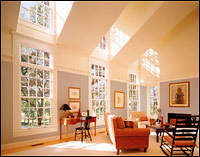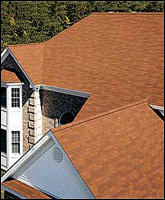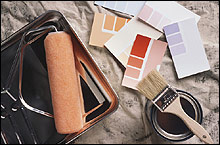|


|
|
 |
Windows
Windows can make or break a building project. Choose wisely and
your home will be comfortable, attractive, and easy to maintain. Buy
the wrong ones and you can spend more than you need to up front or
in higher utility bills for years to come. The doors and windows
that are right for you will depend on the climate you live in and
the design of your house. |
|
|
 |
Roofing
Your roof is critical to basic house performance. It gives your
house identity, shelters you from the weather, withstands sun, wind,
rain, sleet, hail, and snow, and works 24 hours a day to protect the
rest of your home from the relentless forces of nature. A good roof
is tough, graceful, good-looking, and it ages well. To realize that
end, however, you'll need to do three things: design the roof
appropriately, build it right, and take good care of it. |
|
|

|
Insulation
Insulation is a non-structural material that's used to reduce
heat transfer. The most typical forms of insulation available are
rigid sheets, flexible blankets, and loose fill. These may be
composed of fiberglass or rock wool fibers, cellulose (paper)
fibers, and a variety of foams. Specialized insulation, which is
intended to reduce solar heat gain or air and water infiltration, is
sold in plastic or metallized-plastic sheets. |
|
|
 |
Lighting
When it comes to lighting, the biggest challenge is to balance
your practical needs with the vast array of choices for lighting
your home and exterior spaces. Advances in lighting design,
techniques and products have made it possible to create any effect
imaginable with the proper type of light, placement, and fixtures.
These three areas form the heart of lighting design and give
homeowners the keys to designing welcoming, functional spaces that
reflect their taste and individuality. |
|
|
 |
Painting
Of all home-improvements projects, painting is by far the most
common. But there is more to painting an interior than meets the
eye. All paints serve the same basic function, but what separates
them are their durability, thickness, finish, hardness and drying
time. Armed with a little knowledge of paint ingredients, you can
comparison shop the professional and store brands with
confidence.
Wallpaper is the second most common material for
covering interior walls and surfaces. It introduces color, light,
mood, and personality. Unlike paint, however, wallpaper hides the
texture of the wall and imparts its own. Wallpaper also adds another
dimension– pattern or design. |
|
|
 |
Pluming
The topic of indoor plumbing is one that homeowners rarely
concern themselves with--until they discover a leak, run out of hot
water, or begin to remodel the house. While the temptation may be to
call a plumbing contractor to handle things, a little patience and a
willingness to experiment may make plumbing repairs more
straightforward than you think. |
|
|
|
